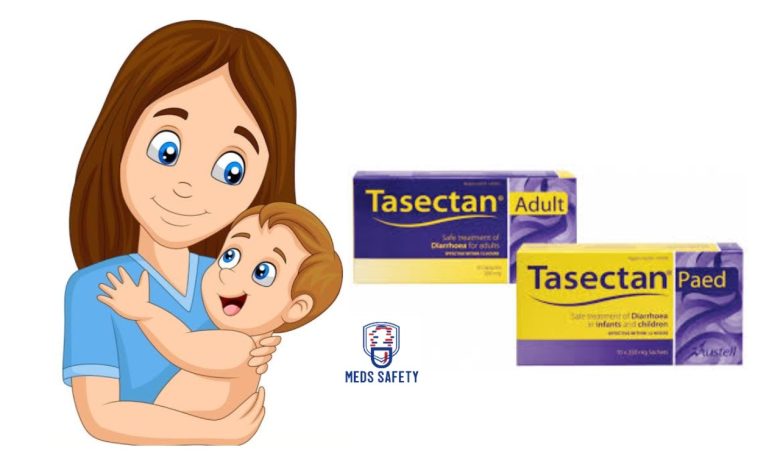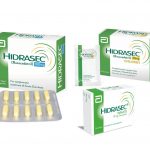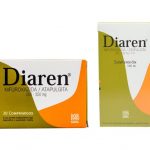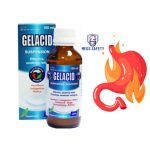Tasectan: Uses, Dosage, Side Effects, Interactions

What is Tasectan used for?
Tasectan is a medication used to treat diarrhea. It contains a substance called gelatin tannate, which is derived from tannic acid. Diarrhea is characterized by the occurrence of three or more loose or liquid stools per day, or a frequency greater than the individual’s normal bowel movements. Typically, it serves as a symptom of an infection affecting the intestinal tract, which can be attributed to various bacterial, viral, and parasitic organisms. This infection commonly spreads through the consumption of contaminated food or water, as well as from person-to-person contact.
The gelatin tannate in Tasectan can help alleviate symptoms such as watery stools, abdominal pain, and discomfort caused by various types of diarrhea, including infectious diarrhea and diarrhea associated with irritable bowel syndrome (IBS).
Tasectan is an over-the-counter medication commonly available in oral suspension or capsule form. You do not need a prescription from your doctor or pharmacist to buy Tasectan
Does Tasectan work?
Yes, Tasectan works to stop diarrhea by forming a protective barrier on the intestinal mucosa to help manage and alleviate symptoms associated with diarrhea. When you have diarrhea, the lining of your intestines becomes inflamed and irritated, leading to an increased loss of fluids and electrolytes from your body. This loss of fluids can result in dehydration and other related symptoms.
Gelatin tannate in Tasectan has adhesive properties, which means it can bind to inflamed intestinal mucosa. When you take Tasectan orally, the gelatin tannate coats the irritated intestinal lining, forming a protective layer within 12 hours of taking the medication. This protective barrier helps reduce the contact between the intestinal walls and the irritating substances present in the stool, which can help soothe inflammation and alleviate symptoms such as abdominal pain, discomfort, and frequent, watery stools.
Additionally, by forming this protective barrier, Tasectan can help reduce the loss of fluids and electrolytes, thus helping to prevent dehydration, which is a common concern with diarrhea.
It is important to remember that Tasectan is not intended to treat the underlying cause of diarrhea; rather, it is meant to manage the symptoms and promote a faster recovery. If you are experiencing persistent or severe diarrhea, it’s essential to consult a healthcare professional for a proper diagnosis and appropriate treatment.
Dosage
The recommended dosage of Tasectan varies based on age. Here are the specific dosages:
1. Adults: Take 1-2 capsules every 4-6 hours until the symptoms of diarrhea disappear.
2. Children under 2 years: It is essential to consult a doctor or pharmacist before giving Tasectan to children under 2 years of age. They will provide appropriate guidance and dosage recommendations.
3. Children aged 2 to 3 years: Take 1 sachet every 6 hours until the symptoms of diarrhea disappear. However, it is advisable to consult a doctor or pharmacist before administering Tasectan to children in this age group.
4. Children aged 3 to 14 years: Take 1 or 2 sachets every 6 hours until the symptoms of diarrhea disappear.
5. Children aged 14 to 18 years: Take 2 sachets every 6 hours until the symptoms of diarrhea disappear.
Please follow the recommended dosages as provided by a healthcare professional or as indicated on the product packaging. If you have any doubts or concerns about the appropriate dosage for your specific situation, consult a doctor or pharmacist for personalized advice and guidance.
Should I take Tasectan before or after meals?
Tasectan can be taken before or after meals, as there are no specific food-related restrictions mentioned for its administration. However, to ensure optimal effectiveness and minimize any potential stomach discomfort, some people may find it helpful to take Tasectan with a glass of water or a light snack.
If you prefer taking Tasectan with food, you can do so. On the other hand, if you choose to take it on an empty stomach, that is also acceptable. The most important thing is to follow the recommended dosage and frequency of administration as advised by your healthcare professional or as indicated on the product packaging.
If you have any specific concerns or questions about how to take Tasectan for your particular situation, it’s best to consult with a healthcare professional or pharmacist who can provide personalized advice based on your medical history and current condition.
Is Tasectan safe for babies and children?
Yes, Tasectan is considered safe for use in babies and children, including infants as young as 3 months old. The product has been formulated with safety considerations for younger age groups, and it can help manage diarrhea symptoms in children effectively.
When giving Tasectan to babies or children, it’s crucial to follow the recommended dosage guidelines provided by a healthcare professional or as indicated on the product packaging. The appropriate dosage will be based on the child’s age and weight, and it’s essential not to exceed the recommended amount.
While Tasectan is generally safe, it’s always a good idea to consult a doctor or pediatrician before administering any medication to infants or children. A healthcare professional can assess the child’s specific condition and medical history to ensure that Tasectan is suitable and safe for use in their case.
If your child experiences any adverse reactions or if their diarrhea persists or worsens after using Tasectan, seek medical attention promptly. Additionally, if your child has any pre-existing medical conditions or is taking other medications, inform the doctor or pharmacist to avoid potential interactions or complications.
Overall, while Tasectan can be considered safe for use in babies and children, responsible and informed usage, as well as professional medical guidance, is essential to ensure the well-being of the child.
Can I take an oral rehydration solution while taking Tasectan?
Yes, you can use an oral rehydration solution along with Tasectan. In fact, combining Tasectan with oral rehydration solutions is a common and effective approach in the management of diarrhea.
Oral rehydration solutions are specially formulated to help replace lost fluids and electrolytes during diarrhea. Diarrhea can lead to dehydration, and these solutions work to restore the body’s fluid balance and prevent complications associated with fluid loss.
Tasectan, on the other hand, helps manage the symptoms of diarrhea by forming a protective barrier on the intestinal mucosa, reducing inflammation, and alleviating discomfort. While Tasectan helps control the diarrhea symptoms, it does not address dehydration directly.
By using an oral rehydration solution in conjunction with Tasectan, you can tackle both aspects of diarrhea management. Tasectan can help reduce the frequency of loose stools and abdominal discomfort, while the oral rehydration solution ensures that the body stays adequately hydrated and replenished with essential electrolytes.
It is important to remember that during episodes of diarrhea, staying well-hydrated is crucial, especially for infants, young children, and the elderly. Along with using Tasectan and oral rehydration solutions, it’s advisable to follow a light diet, including easily digestible foods like bananas, rice, applesauce, and toast (BRAT diet). Avoiding certain foods and beverages, such as caffeine, dairy products, and fatty or spicy foods, can also help manage diarrhea and aid in recovery.
Tasectan side effects
Tasectan is generally well-tolerated, and serious side effects are rare. However, like any medication, it may cause some side effects in certain individuals. Common side effects of Tasectan may include:
1. Gastrointestinal discomfort: Some individuals may experience mild gastrointestinal discomfort, such as bloating, gas, or stomach cramps.
2. Nausea: A feeling of nausea or an urge to vomit may occur in some cases.
3. Allergic reactions: In rare instances, allergic reactions to Tasectan or its ingredients may occur. Symptoms of an allergic reaction may include rash, itching, swelling of the face, tongue, or throat, severe dizziness, and difficulty breathing. If any signs of an allergic reaction are observed, seek immediate medical attention.
It is essential to be aware of potential side effects and to promptly report any unusual or severe symptoms to a healthcare professional. If you have a history of allergies or sensitivity to certain medications, it is especially crucial to inform your doctor before taking Tasectan.
As with any medication, the benefits and risks should be carefully considered, and it’s essential to follow the recommended dosage and usage guidelines provided by your healthcare professional or as indicated on the product packaging.
Interactions
As with any medication, it is essential to be cautious when combining Tasectan with other drugs or supplements to avoid potential interactions.
To ensure your safety and minimize the risk of interactions, consider the following guidelines:
1. Inform your healthcare provider: Before starting Tasectan or any new medication, inform your doctor about all the medications (including prescription and over-the-counter drugs), supplements, and herbal products you are currently taking. This will help your doctor identify any potential interactions.
2. Antacids or other medications: If you are taking antacids or other medications for gastrointestinal issues, consult your doctor before using Tasectan. There may be interactions or effects on the absorption of Tasectan or other medications.
3. Absorption of other medications: Tasectan forms a protective barrier on the intestinal mucosa, which could potentially affect the absorption of other drugs taken concurrently. Allow enough time between taking Tasectan and other medications to avoid any interference.
4. Allergic reactions: If you have known allergies to any medications or substances, discuss this with your healthcare provider, as allergic reactions to any component of Tasectan could occur.
5. Avoid self-medication: Avoid self-medicating or using Tasectan without medical advice, especially in specific medical conditions or if you are taking other medications with potential interactions.
6. Use as directed: Always follow the recommended dosage and usage guidelines provided by your healthcare professional or as indicated on the product packaging.
Tasectan vs Imodium which is better?
The choice between Tasectan and Imodium depends on individual circumstances and preferences. Tasectan’s unique mechanism of action involves forming a protective barrier on the intestinal mucosa, providing relief from diarrhea symptoms while promoting a faster recovery. It is safe for use in infants and children from 3 months old, making it suitable for a broader age range. Tasectan is often used as a complementary treatment to rehydration and is generally well-tolerated. However, Tasectan may not directly address the frequency of bowel movements, which may be a consideration in certain cases.
On the other hand, Imodium’s active ingredient, loperamide, slows down intestinal transit time, leading to firmer stools and decreased bowel movements. It is effective at controlling acute diarrhea and reducing its frequency, but it is generally not recommended for children under 6 years old. However, its widespread availability and familiar usage make it a popular choice for managing diarrhea in adults.
Both Tasectan and Imodium are effective medications for managing diarrhea, but the choice depends on factors such as the individual’s age, the severity of symptoms, and specific medical needs. Consultation with a healthcare professional is crucial to determine the most suitable option based on individual circumstances and to ensure safe and effective relief from diarrhea.





